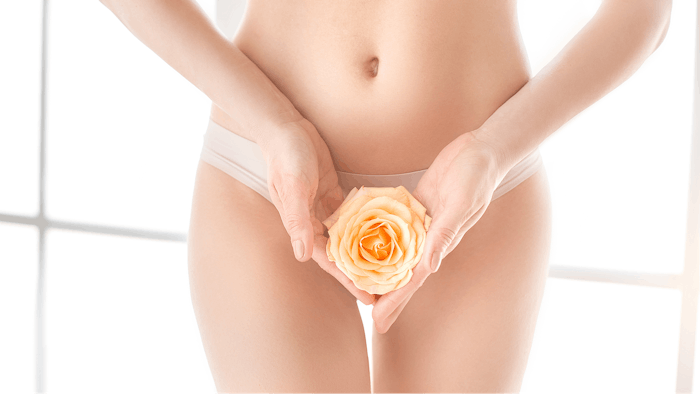
The drive to expand and customize intimate area care product offerings has largely emerged from market demands influencing hair care, skin care and sunscreen product development. In general, the most evident request is for the personalization of products linked to consumer age and skin conditions. In intimate care, this is dictated by differences in the physiological conditions of women in various age groups and possible aggravation of issues such as dry skin, inflammation, infections, malodor, itching and menstruation.
Additionally, current approaches to cleansing are considered by some consumers as insufficient for achieving skin balance or for simply meeting their needs. Therefore, the demand for leave-on intimate care formulas is growing.
Similar to other cosmetic sectors, in intimate care, there is also a need to guide the consumer through the purchasing process; i.e., to provide and/or collect information online to help consumers choose a product that satisfies their specific requirements. Some brands have initiated this process, but unlike skin and hair care, there is not a direct link between the different intimate care needs of women and the specific products that satisfy them. For example, specific products for introductory pediatric use for the hygiene of future adults, or specific products for the elderly who have differentiated hygiene needs are almost completely absent.
Cosmetic products continue to become more individualized and intimate care is no exception. The lack of specialized products for women at various life stages affords an opportunity for the industry. Several factors and biological targets driving the need for expanded offerings are discussed in this article, as well as ingredient ideas and prototype formulas.
Addressing Internal and External Stress
Various situations that can affect the equilibrium of the intimate area are well-known. Examples include:
- Health conditions that can induce harmful changes to skin in intimate areas, such as immunodeficiency, hormonal fluctuations due to menstruation, pregnancy, menopause, aging, etc.;
- Tight and close-fitting clothes that can be an aggravating factor as they prevent the physiological evaporation of moisture from the skin, supporting a warm and humid micro-habitat;
- Some contraceptive systems; and
- Improper hygiene of the intimate skin area.
Formulations for the prevention of infections or adjuvant treatment of drugs in situations of microbial or mycotic infections are already on the market but mainly with a cleansing function. This opens up space for the creation of specific treatment products, such as refreshing gels with antibacterial action, absorbent powders to regulate skin humidity (and absorb odors) or buffering substances to regulate/restore the physiological pH or osmo-protectors for the rebalancing of the osmotic conditions of the skin cells.
Opportunities in Seasons and Age
The demand for intimate care products linked to the passage of time also generally has not been considered.
Environment and behavior: The succession of seasons, aging and changes in habits and lifestyles can change skin conditions and balance in the intimate area. Examples include sexual activity, which can be age-dependent; the use of deodorants and poor hygiene often associated with adolescents; malodor that can emerge in those over 50; dryness during winter months; and/or exposure to unclean environments or high hygienic risk, e.g., swimming pools or beaches during summer months, can aggravate problems.
As mentioned earlier, the supply of cleansers and personal hygiene products for very young consumers is also scarce. Such products would address specific physiological conditions; for example, the continuous use of diapers that retain urine and are prone to stagnation due to continued contact with the mucous membranes.
Biology in youth: Biological changes also present opportunities for targeted intimate care. After birth, the mother devotes attention to the care and hygiene of the diaper area but at prepubescence, this level of attention gradually decreases. During these phases, very few estrogens circulate in the female body; therefore, the presence of glycogen in the mucous membranes is rather scarce and the self-defense microbes Lactobacilli are almost absent.1 Also during this time, the vaginal pH is neutral, tending toward alkaline.2, 3
A lack of hygiene at this stage can favor the onset of infections and predispose individuals to diseases that can accompany them for the rest of their lives. Detergents, wipes or soothing emulsions for intimate areas incorporating prebiotic and/or probiotic agents to restore bacterial flora would be important for the physiological pH and help to create an effective self-defense system.
Biology in puberty and pregnancy: Menstruation and pregnancy are periods during which physiological defenses decrease again, either because vaginal acidity tends to decrease slightly with menstruation or because hormones change. Changes in the female microbiome also have been documented; for more on this subject, see Neumann. In these cases, in addition to menstrual- and pregnancy-specific products, gels or emulsions with protective functions to prevent physiological skin disorders could be beneficial.
Biology in menopause: Menopause typically draws greater attention to one's body due in part to physical (hormonal) changes and mental stress.4 Consumers manage personal hygiene with suitable cleansing and treatment products; demand for products having good sensory profiles is also foreseeable.
Over time, the skin's ability to maintain the correct degree of hydration and good mechanical properties is drastically weakened. Skin dryness can lead to itching and burning conditions while numbers of Lactobacilli self-defense microbes are decreased, significantly increasing the risk of infection.
Thus, with increasing age, emollient products are often required; in addition to, in some cases, products with a marked lubricating action, to avoid any discomfort. Such treatments are necessary to prevent pathologies that lead to altered sebum production or any state of skin imbalance.
The various cleansers and other products used could also be enriched with ingredients having elasticizing, toning, redensifying and moisturizing action on the skin, perhaps even in the form of food supplements; such anti-aging products are particularly widespread in Asian countries.5
Beautifying and Toning the Vaginal Area
Marketers and popular press have, in recent years, promoted aesthetic treatments for the vaginal area following the consumer desire to prolong its youthfulness and keep it in shape. Volume reduction, dryness, atrophy, loss of elasticity and thinning of the dermis occur with aging. As such, demand for vaginal area rejuvenation products and treatments is an important factor to consider for product development.
True anti-aging effects are only achieved through leave-on formulas, with anti-aging claims usually reserved for products for the face and eye area. There are, however, comparable products for the vaginal area, aptly promoted with repulping or facelift claims. Long-lasting lubricating efficacy would be another relevant anti-aging action. One could also create instant relief creams for "rescue” treatments in the case of sudden irritation.
Gel or cream-gel products can additionally be formulated for topical application after the epilation or depilation of the bikini area to provide soothing properties, to combat redness due to hair removal and to provide protective bactericidal properties. Gelled emulsions could incorporate soothing agents such as allantoin, bisabolol, panthenol, aloe, beta-glucan, vegetal antibacterials and refreshing substances.
Finally, skin and pubic hair conditioners are another opportunity; these product types have been around for many years in Asian countries. Thus, while the industry often turns to cleansing as the treatment for most vaginal area concerns, intimate area skin treatments such as the examples provided could have powerful actions.
Approaching the possibilities for intimate area care formulas, one may consider a complex array of ingredient selections. Following are some examples.
Adhesion Promoters
Considering most cleansing products are designed for wash-off application, any active ingredient efficacy would be modest. However, there are formulation and ingredient technologies that make it possible to improve the permanence of functional substances, even in rinse-off products:
- Polymers with adhesion-promoting functionality, such as hydroxypropyl methylcellulose, silicone polymers in microemulsion6 or cationic polymers;
- Polysaccharides such as hyaluronic acid and Tamarindus indica polysaccharide, which also have superficial moisturizing and elasticizing actions;7 and
- Spherulites, which are solid lipid microparticles with hydrophilic or lipophilic cavities that act as adhesion and penetration promoters.8
The concept of adhesion promotion has been extensively studied, especially for applications in the pharmaceutical and cosmetic sector. The mechanisms and methods for quantifying adhesion and/or mucoadhesion have been studied both in the case of leave-on applications, as demonstrated here (see Opuntia ficus indica active), and for rinse-off applications.9-12
The mechanism of mucoadhesion is generally divided into two phases: the contact phase and the consolidation phase. The first phase is characterized by the contact between the mucoadhesive polymer and the mucosa, with the diffusion of the formulation. In the consolidation phase, the mucoadhesive polymers are attracted by the high humidity, which allows them to establish weak van der Waals and hydrogen bonds.13
Formula 1 outlines an intimate cleanser for daily hygiene that can act as an adjuvant in the treatment of candidiasis and vulvovaginitis while providing soothing, anti-irritant and anti-itch actions. This formula is an easily distributed water-based fluid gel that produces a soft and delicate foam that is easy to rinse. It is formulated with highly tolerable surfactants for the mucous membranes and Quillaja saponaria extract, rich in vegetable saponins, with soothing, antibacterial and sebum-normalizing activity.
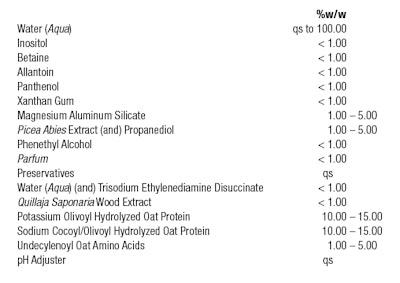 Formula 1. Gynecological Cleanser
Formula 1. Gynecological Cleanser
The formula also contains magnesium aluminum silicate, derived from a natural smectic clay that contributes to softness and gliding properties. Clays are recognized as having good adsorbent power. Furthermore, the Picea abies (spruce fir) extract, rich in polyphenolic compounds (lignans), demonstrates remarkable antioxidant and anti-free radical activity.
Soothing Substances: Antioxidants, Antipruritics
Hydroxytyrosol from Olea europea is a powerful antioxidant present in the leaves and fruits of olive oil. It has an antioxidant capacity superior to that of vitamins E and C. Hydroxytyrosol shows good antimicrobial activity against pathogenic bacteria. It also offers an excellent soothing effects through the inhibition of the nuclear factor κB responsible for the inflammatory activity induced by free radicals.14, 15
Opuntia ficus indica blended with Olea europaeaa provides a combination specifically designed for topical mucosal protection. It combines polysaccharides from prickly pear cactus and cladodes and biophenols from olive tree leaves. This combination has a strong mucoadhesive capacity, thanks to the Opuntia polysaccharides, and shows adhesive activity superior to that of hyaluronic acid (see Figure 1); the soothing effects are due to the olive biophenols (see Figure 2).16, 17
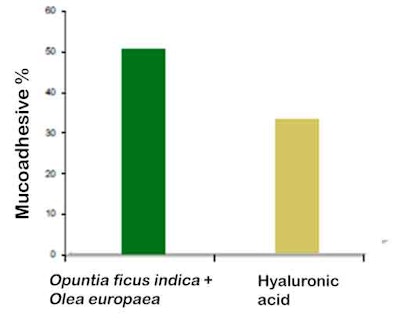 Figure 1. Mucoadhesive activity of Opuntia ficus indica + Olea europea blend vs. hyaluronic acid
Figure 1. Mucoadhesive activity of Opuntia ficus indica + Olea europea blend vs. hyaluronic acid
 Figure 2. Soothing effects of olive extract and Opuntia extract alone vs. blended
Figure 2. Soothing effects of olive extract and Opuntia extract alone vs. blended
Zanthoxylum bungeanum fruit extract is a soothing active ingredient obtained from a perennial plant native to China, Zanthoxylum alatum. It is used as a spice to reduce the irritating power of some foods and, in traditional Chinese medicine, to soothe burns and toothaches. Zanthalene-based preparations have calming and soothing effects to ease burning, itching, skin irritation or burning sensations. These can transiently and reversibly block neuromuscular synaptic transmission by acting on voltage-gated sodium and potassium channels. In vivo tests have demonstrated the ingredient’s calming effect on itching and the perception of heat induced on localized areas of the skin.18
Formula 2 shows a cream-gel with moisturizing action, characterized by high fluidity and softness during massage. It also imparts an emollient and lubricating effect to impart a sense of well-being. The formula contains a balanced blend of vegetable and synthetic oils for smoothness, massageability and an emollient effect. A synergistic complex of osmoprotective active ingredients, i.e., xylitol, inositol, betaine and glycerin, contributes to the moisturizing action and cell protection.
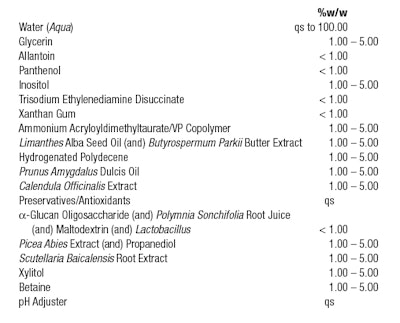 Formula 2. Soothing Intimate Gel
Formula 2. Soothing Intimate Gel
The formulation also contains a plant extract from the roots of Scutellaria baicalensis that is rich in flavonoids and flavones with antibacterial and antifungal activity, as well as an antioxidant and Picea abies (spruce fir) extract, also with antimicrobial and anti-free radical properties. Finally, an ingredient containing prebiotics and probiotics – α-glucooligosaccharides from Polymnia sonchifolia plant juice and freeze-dried Lactobacilli, L. casei and L. acidophilus – selectively stimulates the beneficial bacterial flora of the skin to strengthen its natural defenses against pathogenic microorganisms.
Protective Renewers of Skin Elasticity
Bakuchiol is an inhibitor of enzymes (elastase, collagenase and metalloprotease) that degrade the extracellular fibrous matrix. It reduces inflammatory effects and provides similar efficacy to retinol except with higher stability and tolerability. Bakuciol has superior antioxidant power and also guarantees antibacterial and antifungal actions on the skin, in addition to easing itch.19
Tetrahydrocurcuminoids obtained from the rhizome of Curcuma longa neutralize free radicals with a scavenging effect. More potent than curcuminoid analogues, they protect against UV photo-oxidation, itch and skin aging.20-22
Finally, Boswellia serrata resin extract is an ingredient rich in boswellic acid, known for its anti-free radical and anti-inflammatory properties. Its abilities to inhibit elastase and improve skin elasticity and tone are also recognized. 23, 24
Cell Renewal, Healing
Cell renewal, anti-inflammatory and healing effects are provided by the madecassoside, terminoloside and asiaticoside in purified Centella asiatica extract, which comprises 70-90% of these active constituents. The immunomodulatory action of this ingredient is also demonstrated, as well as its antioxidant activity and promotion of collagen I synthesis, indirectly modulating the metabolism of the connective tissue and promoting the physiological regeneration of the skin.25
Hippophae rhamnoides (sea buckthorn), traditionally used in traditional Asian medicine and, more recently, in Western medicine, is known for its tonic, revitalizing and regenerative activities for skin and mucous membranes.26 Sea buckthorn oil is also recognized for healing wounds and burns, especially in combination with olive oil.27 Incorporated into slow-release microcapsules, it can carry out prolonged action by releasing the essential polyunsaturated fatty acids of olive in a controlled manner.
Prebiotics and Probiotics
Now widely used in the cosmetics sector, prebiotic ingredients aim to improve the ratio between desired and undesired microorganisms, which could be useful for intimate care products. One example is an α-glucan oligosaccarideb, which can act as a bioselective substrate for the growth of saprophytic microflora, counteracting the growth of pathogenic strains and unwanted microflora (see Table 1).28
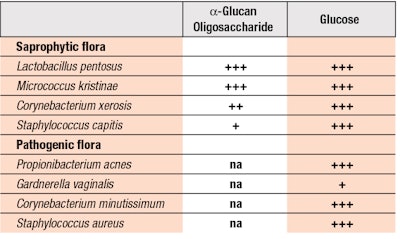 Table 1. Effects of α-Glucan Oligosaccharide vs. Glucose in Native and Pathogenic Flora
Table 1. Effects of α-Glucan Oligosaccharide vs. Glucose in Native and Pathogenic Flora
The idea of using prebiotic ingredients to create a favorable environment for the proliferation of naturally resident bacterial flora can be extended to probiotic ingredients. The World Health Organization defines probiotics as live microorganisms that, when administered in adequate quantities, confer healthy benefits.
However, unlike foods, e.g., yogurt and powdered supplements, the application of probiotics in cosmetics is not so straightforward. This is due in part to regulatory issues. For example, the U.S. Food and Drug Administration limits the bacterial load in cosmetic products – it is not to exceed 1,000 cfu (500 for the eye contour area), while the cosmetic industry has self-regulated at values lower than 10 cfu.10 Probiotics, if delivered intact, would add to the existing load.
It is evident that the use of suitable Lactobacilli strains in topical products can bring excellent benefits to the skin.31, 32 Furthermore, in some cases, microorganisms are also subjected to stress (e.g., UV, heat, etc.) to increase their production of substances that improve protection against exogenous stress.
Numerous studies have also analyzed the effects of the oral, rather than topical, administration of microorganisms in terms of mucosal colonization, i.e., adhesion to human epithelial cells; or microbial antagonism, i.e., the production of hydrogen peroxide or antimicrobial activity against some pathogens.33, 34
The vaginal mucosa is colonized by different strains of Lactobacilli belonging to different species; for more on this, see Neumann. Among the microorganisms studied, those showing the greatest efficacy in preventing infections by their oral administration included L. crispatus CTV05, L. rhamnosus GR-1 and L. fermentum RC-14.35
Normalizing Intimate Care
A few years ago, celebrity Gwyneth Paltrow attempted to break the taboo surrounding this most intimate area of the female anatomy with the controversial launch of her candle named, “This Smells Like My Vagina,” by Goop. According to one news source,36 Paltrow claimed this provocation was intended to convey that “it’s amazing to be a woman in every way,” to empower women. Other marketers have stepped up as well, with “V beauty” and “femcare” product offerings supporting an intimate wellness market valued at $13.9 billion in 2023, per Reckitt’s Intimate Wellness US Market; for more on this, see Tarakanova.
However, intimate care still remains a little-frequented topic. Vaginal beauty and wellness represents something of an unknown for eight out of 10 women who do not feel comfortable talking about female genitalia and who do not take adequate care of their intimate well-being. Treating intimate areas to enhance natural beauty and health should be included with, and become as normalized as, daily skin care routines.
This category of ingredients deserves further consideration. The trend of probiotics is constantly growing. The probiotics market is predicted to grow at a rate of 8.1% between 2022 and 2027, reaching a value of $85.4 billion by 2027 from a projection of $57.8 billion in 2022.29
a Mucosave (INCI: Opuntia Ficus Indica Extract (and) Olea Europaea (Olive) Leaf Extract (and) Maltodextrin) is a product of Bionap S.r.l.
b BioEcolia (INCI: Alpha-Glucan Oligosaccharide) is a product of Solabia Group.
References
1. Auriemma R. et al., (2021). The vaginal microbiome: A long urogenital colonization throughout woman life. National Library of Medicine. Available at https://www.ncbi.nlm.nih.gov/pmc/articles/PMC8290858/
2. Pybus, V. and Onderdonk, A.B. (1999, Apr). Microbial interactions in the vaginal ecosystem, with emphasis on the pathogenesis of bacterial vaginosis. National Library of Medicine. Available at https://pubmed.ncbi.nlm.nih.gov/10602662/
3. Boskey, E.R., Telsch, K.M., Whaley, K.J., Moench, T.R. and Cone, R.A. (1999, Oct). Acid production by vaginal flora in vitro is consistent with the rate and extent of vaginal acidification. National Library of Medicine. Available at https://pubmed.ncbi.nlm.nih.gov/10496892/
4. Clarke, M.A., Rodriguez, A.C., Gage, J.C., Herrero, R., Hildesheim, A., Wacholder, S., Burk, R. and Schiffman, M. (2012, Dec). A large, population-based study of age-related associations between vaginal pH and human papillomavirus infection. National Library of Medicine. Available at https://pubmed.ncbi.nlm.nih.gov/22316377/
5. Reynolds, E. (2022, Sept). K-Beauty for your vulva? How Rael applies South Korean innovation to intimate care. Marie-Claire. Available at https://www.marieclaire.com/career-advice/rael-kbeauty-vulva-care/
6. Johnson, B., Canfield, L., Oycke, S., Dubois, C., Dupont, A., Letouche, C. and Scavuzzo, T. (2006). New approaches for assessing conditioning and quantifying silicone deposition on hair. Semantic Scholar. Available at https://bit.ly/3qJ5V2O
7. Xilogel. (Accessed 2023, Aug 28). UL Prospector. Available at https://www.ulprospector.com/en/na/PersonalCare/Detail/4243/193894/Xilogel
8. Spherulites. (Accessed 2023, Aug 24) Science Direct. Available at https://www.sciencedirect.com/topics/engineering/spherulites
9. Lu, S., Lu, J. and Liu, L. (2012, March). Reversely thermo-reversible hydrogel compositions. U.S. 20120244097 A1. U.S. Patent Office. Available at https://patents.google.com/patent/US20120244097A1/en
10. Rossi, et al. (2014). Associations of natural polymers to modulate mucoadhesion of vaginal rinse-off and leave-on formulations. Science Direct. Available at https://www.sciencedirect.com/science/article/abs/pii/S1773224714500949
11. Camuzat, C., et al. (2008). Les sphérulites, la vectorisation flexible (Spherulites: Flexible targeting). ITECH Catalogue en ligne. Available at https://e-campus.itech.fr/pmb/opac_css/index.php?lvl=author_see&id=13424
12. Boyd, T. and Leigh, L. (2011, Jan). Oral care formulations for malodor control. AU2011210803B2. Australian Patent Office. Available at https://patents.google.com/patent/AU2011210803B2/en
13. Hogerstrom, H., Edsman, K. and Strwmme, M. (2003). Low-frequency dielectric spectroscopy as a tool for studying the compatibility between pharmaceutical gels and mucus tissue. Available at National Library of Medicine. https://pubmed.ncbi.nlm.nih.gov/12950005/
14. Killeen, M., et al. (2014). NF-κβ signaling and chronic inflammatory diseases: Exploring the potential of natural products to drive new therapeutic opportunities. National Library of Medicine. Available at https://pubmed.ncbi.nlm.nih.gov/24246683/
15. Luder, M. et al. (2008). Hydroxytyrosol from olives, an interesting radical scavenger for cosmetic applications. SOFW. Available at https://www.sofw.com/en/sofw-journal/archive/archive-2/374-sofw-journal-7-2008
16. Rizza, L. et al. (2012). Caco-2 cell line as a model to evaluate mucoprotective proprieties. National Library of Medicine. Available at https://pubmed.ncbi.nlm.nih.gov/22101284/
17. Dekanski, D. et al. (2009). Attenuation of cold restraint stress-induced gastric lesions by an olive leaf extract. National Library of Medicine. Available at https://pubmed.ncbi.nlm.nih.gov/19893091/
18. Artaria, C., Maramaldi, G. and Appendino, G. (2011). Sichuan pepper as a skin spice. ResearchGate. Available at https://www.researchgate.net/publication/266886082_Sichuan_pepper_as_a_skin_spice
19. Chaudhuri, R.K. and Bojanowski, K. (2014). Bakuchiol: A retinol-like functional compound revealed by gene expression profiling and clinically proven to have anti-aging effects. National Library of Medicine. Available at https://pubmed.ncbi.nlm.nih.gov/24471735/
20. Sugiyama, Y. (1996). Involvement of the beta-diketone moiety in the antioxidative mechanism of Tetrahydrocurcumin. National Library of Medicine. Available at https://pubmed.ncbi.nlm.nih.gov/8759023/
21. Nakamura, Y., et al. (1998). Inhibitory effects of curcumin and tetrahydrocurcuminoids on the tumor- promoter-induced reactive oxygen species generation in leukocytes, in vitro and in vivo. J National Library of Medicine. Available at https://pubmed.ncbi.nlm.nih.gov/9617340/
22. Holder, G.M., et al. (1978). The metabolism and excretion of curcumin (1,7-bis-(4-hydroxy-3-methoxyphenyl)-1,6-heptadiene-3,5-dione) in the rat. National Library of Medicine. Available at https://pubmed.ncbi.nlm.nih.gov/726520/
23. Safayhi, H., et al. (1997). Inhibition by boswellic acids of human leukocyte elastase. National Library of Medicine. Available at https://pubmed.ncbi.nlm.nih.gov/9103531/
24. Singh, G.B., et al. (1996). Anti-inflammatory actions of boswellic acids, Phytomedicine. Available at https://pubmed.ncbi.nlm.nih.gov/23194868/
25. Belcaro, G., et al. (2010). TECA (Titrated extract of Centella asiatica): New microcirculatory, biomolecular and vascular application in preventive and clinical medicine. National Library of Medicine. Available at https://pubmed.ncbi.nlm.nih.gov/22108486/
26. Bawa, A.S., Khanum, F. and Singh, B. (2002). Seabuckthorn a wonder plant. NIScPR Online Periodicals Repository.. Available at https://nopr.niscpr.res.in/handle/123456789/12352
27. Edraki, M., et al. (2014, Jul). Healing effect of sea buckthorn, olive oil and their mixture on full-thickness burn wounds. National Library of Medicine. Available at https://pubmed.ncbi.nlm.nih.gov/24932952
28. BioEcolia. (Accessed 2023, Aug 28). Prebiotic, microbiota protecting inducer. Solabia Group. Available at https://www.solabia.com/cosmetics/en/product/bioecolia/
29. Ahuja, K. and Bayas, S. (2023, Mar). Probiotics market size by ingredients (Lactobacilli, Bifidobacterium, Streptococcus, Bacillus), by end-use (human, animal), by application (food and beverages, dietary supplements, animal feed) and forecast, 2023 – 2032. Global Market Insights. Available at https://tinyurl.com/486vd3pj
30. Laboratory methods (food). (Accessed 2023, Aug 24). FDA. Available at https://www.fda.gov/food/science-research-food/laboratory-methods-food
31. Muizzuddin, N., Maher, W., Sullivan, M., Schnittger, S. and Mammone, T. (2012, Nov). Physiological effect of a probiotic on skin. National Library of Medicine. Available at https://pubmed.ncbi.nlm.nih.gov/23286870/
32. Krutmann, J. (2009, Apr). Pre- and probiotics for human skin. National Library of Medicine. Available at https://pubmed.ncbi.nlm.nih.gov/19203862/
33. Reid, G. (2001). Probiotic agents to protect the urogenital tract against infection. National Library of Medicine. Available at https://pubmed.ncbi.nlm.nih.gov/11157354/
34. Mastromarino, P., et al. (2002). Characterization and selection of vaginal Lactobacillus strains for the preparation of vaginal tablets. National Library of Medicine. Available at https://pubmed.ncbi.nlm.nih.gov/12392537/
35. Reid, G., et al. (2003, March). Oral use of Lactobacillus rhamnosus GR-1 and L. fermentum RC-14 significantly alters vaginal flora: Randomized, placebo-controlled trial in 64 healthy women. National Library of Medicine. Available at https://pubmed.ncbi.nlm.nih.gov/12628548/
36. Brockington, A. (2022, Jul 24). Gwyneth Paltrow explains why she sells vagina-scented candles. Today. Available at https://www.today.com/popculture/popculture/gwyneth-paltrow-explains-sunday-todays-willie-geist-sells-vagina-scent-rcna39747










